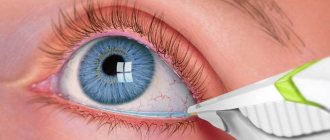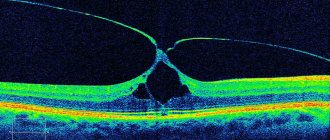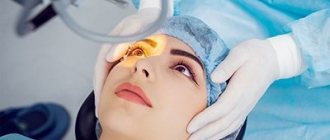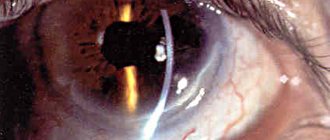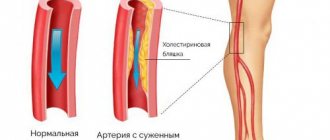Meibomian blepharitis is a type of inflammation of the ciliary edge of the eyelids, which is characterized by increased secretion and inflammation of the sebaceous (meibomian) glands. Most often, the disease occurs in a chronic form, with constant exacerbations, which significantly complicates life and can lead to decreased vision. When the first symptoms of the disease appear, it is important to undergo comprehensive treatment, and then prevent inflammation of the eyelids - maintain visual hygiene, carefully select eye cosmetics, strengthen the immune system, promptly treat infectious diseases of the nasopharynx and metabolic disorders.
The causes of this disease can be different, but most often it occurs in women. This is justified by the regular use of cosmetics, which in turn provokes clogging of the sebaceous glands, which are located deep in the cartilage of the eyelid. But cosmetics are not the only reason. Infectious diseases of the nasopharynx cause clogging of the sebaceous glands. The cause may also be the presence of chronic diseases, hormonal imbalance, gastritis and more.
In children, meibomian blepharitis occurs due to touching the eyes with dirty hands.
Symptoms
Meibomian blepharitis is distinguished by the following symptoms:
- the photo of meibomian blepharitis shows that the eyelids turn red and shine (as if there is an oil mask on them);
- the edges of the eyelids thicken and become denser;
- eyes itch;
- itching, burning, pain occurs;
- discomfort appears in the wind, bright light (photophobia);
- the eyes get tired quickly even with normal load (this makes the eyelids become heavier);
- the condition of the eyelashes becomes worse: they break, thin out, turn gray, and fall out;
- there is dryness of the eyes or, conversely, tearing;
- in the photo of meibomian blepharitis you can see puffiness and swelling of the eyelids;
- vision clarity deteriorates;
- Yellow secretions accumulate in the meibomian glands; when pressed, they come out.
When the inflammatory process spreads from the eyelids to the mucous membrane of the eyes, the following symptoms are added to the listed signs (treatment in this case becomes difficult):
- the photo of blepharitis shows redness of the eyeball;
- expansion of the capillaries of the sclera is observed;
- there is a white veil before my eyes;
- the picture in the field of vision blurs.
If meibomian blepharitis also affects the mucous membrane, then not only yellow liquid, but also pus and mucus may come out of the eyes. You can see what it looks like in the photo of blepharitis.
Symptoms of the disease
Inflammation of the meibomian glands has symptoms similar to other blepharitis:
- increased eye fatigue;
- photophobia;
- increased lacrimation;
- acute sensation of itching and burning of the mucous membrane.
In the chronic stage of blepharitis, eyelashes begin to grow incorrectly, which can lead to their ingrowth or loss. The glands become clogged with a viscous oily secretion and take the form of white or yellow bubbles. When you press on them, a few drops of thick liquid are released.
With meibomian blepharitis, the symptoms do not go away on their own, but only get worse over time, and treatment will require more effort.
Photo of the eye with meibomian blepharitis
This form of blepharitis can be distinguished from other eye pathologies visually. Translucent whitish bubbles form along the edges of the eyelids. You can see them in the photographs below.
Bubbles that are clearly visible in photographs should under no circumstances be opened with one’s own hand, as there is a risk of introducing an infection into the eyes and causing concomitant diseases, for example, conjunctivitis.
When the formations open on their own, small scars appear in their place. You won't be able to see them in photographs. Scars can only be detected when examined under a microscope by an ophthalmologist.
Blepharitis affects the upper or lower eyelids of the eyes. It can also affect both at once, as shown in the photo below.
Meibomian blepharitis is characterized by a sluggish course. It may not be observed constantly, but in outbreaks.
Causes
Meibomian blepharitis occurs for several reasons. You should be wary of symptoms of the disease if:
- There are disturbances in the functioning of the immune system (autoimmune diseases, HIV, etc.).
- There are endocrine problems (diabetes mellitus, hyperthyroidism).
- There is a chronic inflammatory process in the body (pyelonephritis, bronchitis, tuberculosis).
Meibomian blepharitis can also be caused by:
- damage to the organs of vision by mites (demodex);
- improper eyelash growth;
- systematic contact with allergens.
Meibomian blepharitis most often occurs with Demodex. Microscopic-sized mites successfully live on human eyelashes without causing much concern. This condition can be considered normal until Demodexes begin to actively reproduce.
The waste products of mites cause unpleasant symptoms: itching, irritation and pain in the eyes. There is an abundant secretion of secretion, which “glues” the eyelashes together and only increases discomfort.
If you look at the secretion and eyelashes of a person through a microscope, you can see a stack of mites, which will be shaped like coins.
Treatment of meibomian blepharitis
To select an effective treatment regimen, the doctor needs to determine the pathogenesis of the disease. Provoking factors for meibomian blepharitis may include:
- autoimmune diseases;
- infection with tuberculosis bacillus;
- problems in the endocrine system;
- tonsillitis, sore throat;
- streptococcal infection;
- carious teeth;
- weakening of the immune system;
- eye pathologies;
- gastrointestinal diseases;
- chronic anemia.
To get rid of the disease forever, you need not just to stop the symptoms, but to cure the pathology that provoked it. The photographs show that blepharitis causes not only physical, but also aesthetic discomfort. It is necessary to begin treatment of the pathological condition as quickly as possible.
To treat the cause of meibomian blepharitis, complex therapy is used, including:
- elimination of chronic foci of infection;
- balanced diet;
- compliance with personal hygiene rules;
- timely treatment of allergic diseases;
- immediate treatment of myopia, farsightedness, astigmatism;
- manipulations to strengthen the immune system.
Treatment of blepharitis and related pathologies includes:
- cleansing activities using antiseptics, infusions, and herbal decoctions;
- warm compresses;
- oral and topical use of medications;
- eyelid massage;
- physiotherapy.
During treatment you need to discard lenses. They can be replaced with glasses with tinted lenses to protect your eyes from ultraviolet rays. Also, if you have blepharitis, you must avoid cosmetics and personal care products.
Treatment options
The peculiarities of the treatment of pathology are that noticeable results can be seen only after a few weeks. During the initial stages of treatment for chronic meibomian blepharitis, it is important to remain patient, even if there seems to be no effect.
Therapeutic measures involve a combination of medications and folk remedies, and physiotherapeutic procedures. Medicines are the main way to suppress inflammation of the meibomian glands:
- hygienic treatment of eyelids with “Blepharogel” allows you to prepare them for the effects of basic medications;
- skin treatment with “Chlorhexidine”;
- application of antibacterial ointments - “Erythromycin”, “Tetracycline”;
- with the development of concomitant conjunctivitis, antibacterial drops are added to the treatment - “Normax”, “Tsipromed”.
Systemic therapy, including the use of immunostimulants, vitamins, and antihistamines, is no less important.
You should consult your doctor about the possibility of using folk remedies. They can be used as an adjunct to drug therapy:
- washing the eyes with a decoction of herbs - chamomile, sage, mint;
- lotions with green tea;
- compresses with potato juice.
Before using medications, it is recommended to massage the eyelids. This procedure helps to open the meibomian glands and cleanse them of inflammatory secretions. The massage is carried out after hygienic treatment of the eyelids, with clean hands or a special eye stick.
Additionally, read the article: treating blepharitis at home.
Physiotherapy procedures have a good effect for meibomian blepharitis:
- magnetic therapy;
- darsonvalization;
- UHF;
- electrophoresis.
Physiotherapy improves blood circulation and promotes the outflow of sebum.
Physiotherapy
The following physiotherapeutic procedures are used for treatment:
- UHF - exposure to a high frequency electric field. The procedure lasts no more than a quarter of an hour. This treatment method has an anti-inflammatory effect.
- Magnetotherapy is treatment with a magnetic field. Relieves pain, relieves swelling, eliminates swelling.
- Light therapy with ultraviolet rays reduces inflammation and strengthens local immunity.
To achieve the desired result in treatment, you need to attend 8-9 sessions. At home, to cure meibomian blepharitis, you can massage the eyelids yourself. Hands must first be washed thoroughly with soap. The eyelid is massaged first clockwise and then counterclockwise. The procedure takes approximately 5–7 minutes.
Additional treatment
To get rid of the signs of the disease as quickly as possible, the ophthalmologist may recommend going through a number of additional procedures:
- massage with anti-inflammatory and antibacterial ointments - carried out using a glass rod and specialized preparations, it is painful and highly effective;
- magnetic therapy, UHF - procedures will help speed up the recovery process and significantly enhance drug therapy.
It is difficult to call meibomian blepharitis a complex or dangerous disease. But this does not mean that the disease cannot lead to serious complications. For this reason, you should not try to get rid of the signs of the disease on your own or ignore them altogether. This can lead to decreased visual acuity and the development of chronic blepharitis.
Symptoms of meibomian blepharitis
Visually, the disease differs significantly from other types of blepharitis. It is also characterized by specific symptoms:
- If you examine the eyelash line, as well as the upper part of the eyelid, then during the examination small translucent bubbles are detected. They are the result of an inflammatory process affecting the meibomian glands.
- When a blister is removed (accidentally or intentionally), a pinpoint scar is later formed in its place. In some cases, such traces of removal may be absent.
- On visual examination, hyperemia and thickening of the eyelid margin are observed.
- The inflamed edge of the eyelid looks as if it has been treated with oil, i.e. the skin shines.
- If you press on the cartilage, a secretion of an oily consistency will begin to appear.
- The patient experiences increased lacrimation.
- The pathology is characterized by maceration of the inflamed edge of the eyelid, i.e. it swells, absorbing excess liquid by the skin.
Diagnostics
The initial symptom of meibomian blepharitis is just a slight redness of a small area of the eyelid, accompanied by a low-grade inflammatory process. That is why a sick person does not always pay attention to this. If treatment is not started on time, acute meibomian blepharitis becomes chronic.
Diagnosis of the disease involves a full examination of the inflamed eyelid, as well as an oral survey that allows you to study existing complaints. To exclude a bacterial infection, which quite often is associated with blepharitis, eye cultures are prescribed. Additionally, consultation with the following specialists is required:
- dermatologist;
- endocrinologist;
- allergist.
Causes of the meibomian form
As with the demodectic form, meibomian blepharitis occurs due to infection by mites, but this is extremely rare. The main cause is an infection in the meibomian glands. Predisposing factors for the development of pathology:
- Reduced immune system.
- Poor metabolic processes in the eye organ.
- Sinusitis.
- Frontit.
- Tonsillitis.
- Caries.
- Diabetes.
- Tuberculosis.
- Helminthiasis.
- Anemia.
- Astigmatism.
- Myopia.
- Farsightedness.
- Dry eye syndrome.
Treatment of the chronic form
In the absence of adequate treatment, acute meibomian blepharitis becomes chronic. Unfortunately, it is completely impossible to cure it. The main thing in the process of treating a chronic form is to try to eliminate the causes that provoke an exacerbation of the disease.
Treatment of meibomian blepharitis in chronic form involves the following procedures:
- washing the eyelids and eyes;
- cleaning inflamed eyelids from oily secretions;
- use of lotions;
- performing a massage.
This type of blepharitis is very difficult to treat. Relapses of the disease are quite common, but sometimes the disease may not manifest itself for several years. Upon completion of therapy, repeated studies must be performed.


